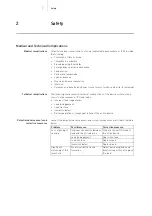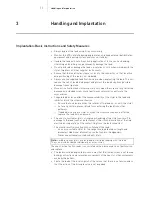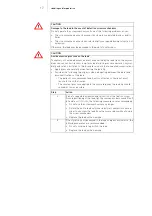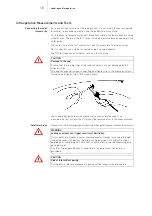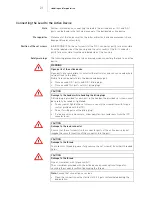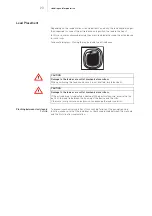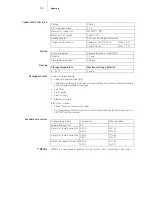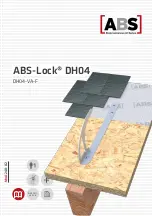
11
Handling and Implantation
3
Handling and Implantation
Handling and Implantation3414086Technical ManualProtego DF-1 S
Implantation: Basic Instructions and Safety Measures
•
Always implant the lead using X-ray monitoring.
•
Monitor the ECG carefully during implantation and keep external defibrillation
equipment and a pacing system analyzer on standby.
•
Handle the lead with care. Any strong application of force, such as bending,
stretching and kinking, can permanently damage the lead.
•
Do not perforate or damage the lead's insulation or coils when working with the
stylet, tweezers, or other surgical instruments.
•
Ensure that the lead fixation sleeve is close to the connector, so that insertion
and positioning of the lead is not hindered.
•
Always use the supplied lead fixation sleeve when implanting the lead. This will
reduce the risk of lead dislodgment and protect the lead body from possible
damage from a ligature.
•
Move active fixation leads intracorporally only when the screw is fully retracted
because an extended screw could tear the vascular wall or perforate the
myocardium.
•
Coagulated blood can affect the maneuverability of the stylet in the lead and
inhibit or block the screw mechanism.
— Ensure that no blood reaches the interior of the lead on, or with, the stylet.
— As far as possible, prevent blood from entering the lead from other
pathways.
— If needed, use a spare stylet or, when the screw mechanism is affected,
replace the lead with a new one.
•
The use of unsuitable stylets or improper handling of the stylet can result in
damage to the lead (such as detachment of the silicone insulation at the ring
electrode or separation of the contact ring from the lead connector).
This would result in a malfunction or failure of the lead.
— Use only a suitable stylet for the respective lead (based on length and
diameter). Additional information can be found in the Appendix.
— Never use extremely curved or bent stylets.
Note:
Suitable spare stylets are included in sterile packaging with the lead.
They can also be ordered individually as accessories.
The use of active fixation leads is associated with an increased risk of perforation
and rupture.
•
The lead should be implanted in such a way that the fixation screw is not tensed
during contraction and relaxation movements of the heart or other movements
made by the patient.
•
Fixate the lead at the incision point of the vein so that there is no tension and so
that the action of the tricuspid valve is not impeded.







